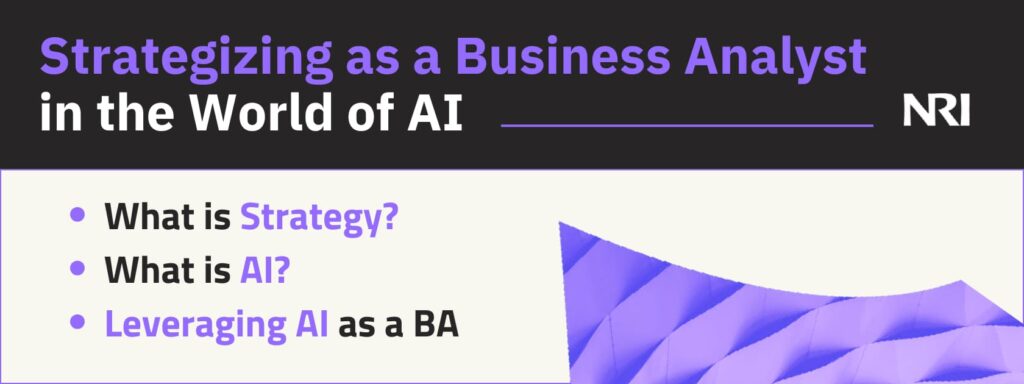AI is here. Will you use it to drive smarter strategies?

The role of a Business Analyst (BA) is evolving rapidly with the rise of Artificial Intelligence (AI). BAs must not be complacent about AI tools and capabilities; we must incorporate AI into our decision making and functional execution. But what does that look like in practice? How can Business Analysts effectively leverage AI to stay relevant in a rapidly shifting landscape? Let’s explore the intersection of strategy, AI, and Business Analysis in greater detail.
What is Strategy?
Strategy is about achieving short- and long-term objectives through thoughtful, proactive analysis. Here, you look at pain points beyond the surface level to identify root causes and long term considerations to create effective solutions that address the actual problem, not just the symptoms as well as ensuring the solution can extend to future needs and capabilities. The goal is to react less and prevent challenges more..
In addition to clarifying the real problem, strategy is about prioritizing efforts—evaluating needs, and allocating resources based on urgency, business value, and long-term scalability and extensibility. More importantly, it’s about taking a big-picture approach—continuously looking at how different pieces fit together—so you can build today with tomorrow in mind. To use an analogy, strategy involves an overarching understanding of the forest, not just the individual trees. Understanding the ecosystem that tree lives in is vital to identify everything you need to address to solve the problem long-term and avoid unintended consequences that could hurt your business.
That said, there are several layers of strategy that BAs should be familiar with:
- Market Strategy: This is about understanding external factors like industry shifts, competitor actions, and macroeconomic influences and taking proactive steps to increase overall competitiveness. How does your product(s) actually fit in the market? Are you performing well relative to competitors? Should you change the things you focus on as a business?
- Business Strategy: This is more operational. You examine the organization’s internal capabilities and how different functions interact to deliver value. What must you do to function well with efficiency and quality? How effective are you at them? What are the capability levels for each function? How critical is each function?
- Functional Strategy: This involves a more detailed examination of the step-by-step process, tools and skills used in a specific function, potentially spread across specific areas of your business. For example, in an accounting department and the purchasing process impact many areas of a business.Understanding the holistic impact a function helps you to understand your business better and identify overall improvements from a functional yet holistic perspective.
- Product Strategy: This feeds off of your market strategy. It’s about refining or developing new offerings based on customer needs, market demand, and emerging trends to gain more market share. For example, based on your market position and current trends, is there a new product or a modification to your existing product that can help you further differentiate or address a new need in the market?
- Project Strategy: This is about ensuring that we address specific solution needs in a way to allow for short term value with long term vision. For example, modernizing or developing custom software can be very expensive if we don’t consider future capability a business will need from a particular technology solution. Strategizing a solution with consideration to bigger picture, long term needs can save significant time over time. If you invest a small percentage of time up front, it can save significant time throughout the life of the solution because you will have less undo, redo to contend with.
Now, let’s talk about AI and its role in strategy.
What is AI?
AI simulates human intelligence. It learns from data, puts pieces together, and reasons the patterns out to solve problems. This is based on the perception of the data provided, and AI has to understand human language, not just ones and zeros or .NET language.
There are three main AI categories:
- Narrow AI: This type of AI focuses on pattern recognition. It helps with specific tasks like image recognition, language translation, and identifying opportunities for efficiency. This has been around for a long time and, at one time, was strongly considered to not be AI. Today, it has been included under the umbrella of that which is or feeds AI. Think machine learning, natural language processing and the like.
- General AI: This is a more advanced model capable of independent, high-level reasoning and decision-making in diverse scenarios. This goes beyond structured, attended automated decisioning. This is when the AI engine comes to its own conclusions with much less, if any supervision. Think Chat GPT, Grock, Perplexity and the like.
- Super Intelligent AI: In theory, this AI surpasses human intelligence and is more adept at reasoning and problem-solving. This is where AI becomes quite good at not only problem solving based on the data most people think of, but begins to interpret people and their emotions, such as observing body language, considering speech tone and cadence and the like.
AI requires human oversight as it can evaluate and provide guidance based on incorrect information or even make up answers, which is called AI hallucination. Fortunately, you can give AI feedback when it is off and it will rethink and provide a better response. This requires the Business Analyst to be familiar enough to recognize when something doesn’t seem accurate. AI responses will only be as good as the data AI is trained on, meaning you may end up with inaccurate insights when using poor-quality or biased data. As AI becomes more autonomous, human oversight is vital in ensuring transparency and fairness in decision-making.
How Business Analysts Can Leverage AI For Strategy
There are several practical ways to integrate AI into your strategy. One is to leverage it to analyze and understand industry trends and market positioning. You can use AI to comb through company and industry resources to identify, for example, what’s going on in the market and current macroeconomic events and tie these together for a more comprehensive view. The most advanced AI engines will often tell you what’s factual, what factors they are predicting based on, how probable something is, and similar elements.
AI can streamline process optimization by automating inefficiency detection. Instead of manually creating a process model and analyzing each step with colleagues to determine timing and identify bottlenecks, you can simply input the process into an AI system. The AI will track each step, detect inefficiencies, and suggest improvements automatically.
For a claims management example, consider a business rule requiring all claims over $500 to be reviewed by a manager. If 75% of claims exceed this threshold, it creates a major bottleneck, slowing processing times and increasing customer churn. AI can identify this inefficiency and analyze fraud data to provide better insights. For example, if 90% of fraudulent claims involve amounts over $1,000, but only 5% of total claims fall into that range, the current rule is unnecessarily delaying most claims. Adjusting the threshold based on AI-driven insights can improve risk management and significantly speed up claims processing.
Beyond using AI for strategy, consider using this powerful technology in other aspects of your daily tasks if you aren’t already. For example, use it to draft emails, summarize information from recorded meetings, and sift through emails to find requirements or tasks you need to follow up on. AI can automatically schedule meetings, update your calendar to reserve time for focus work, to draft documents or presentations and much more.
Stay Ahead in the AI Era
So, what’s the secret sauce to thrive in the AI era as a business analyst? Continuous learning and adaptation. Stay curious about AI and be willing to experiment with new tools. Remember, AI is here to augment you, not replace you. So, you should see it as a powerful ally that helps enhance your decision-making, provides you with deeper insights, and handles mundane tasks so you can focus on the higher-value ones.
Step up, be bold, and let your strategic expertise shine as you lead your organization into a future where AI and human creativity work together.
Read our eBook Unlocking the Power and Promise of Generative AI to learn more about staying ahead in the era of AI.






Share on